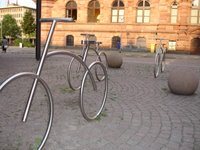 Wiesbaden, which a recent visitor (Rob Homeyer) phonetically spelled Veesbaaden, is a town with about 300,000 of zee Chermans. The Yankee population totals about 5,000 peeps, so it’s really quite often (and quite unfortunate) that you see the gray Disney characters sweatshirt that has marked American travelers for the better part of 20 years. But, I guess if you compare that to the equally stereotypical spikey hair, chunky-glasses-wearing, small-collared-jacket sporting European who’s probably sporting a speedo underneath his tight jeans, they kinda equal out. Man, I’m going to hell.
Wiesbaden, which a recent visitor (Rob Homeyer) phonetically spelled Veesbaaden, is a town with about 300,000 of zee Chermans. The Yankee population totals about 5,000 peeps, so it’s really quite often (and quite unfortunate) that you see the gray Disney characters sweatshirt that has marked American travelers for the better part of 20 years. But, I guess if you compare that to the equally stereotypical spikey hair, chunky-glasses-wearing, small-collared-jacket sporting European who’s probably sporting a speedo underneath his tight jeans, they kinda equal out. Man, I’m going to hell.Anyway, as unassuming as the town may seem, Wiesbaden can be known as the Forrest Gump of all German cities, being that it has inadvertently and unexpectedly found itself at the center of many significant historic events. Let’s discover Wiesbaden:
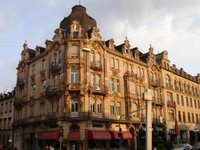
HISTORY
Like many European cities, Wiesbaden dates back to the time when dinosaurs had their own advanced civilization (like in that show with the purple dino baby with the frying pan who says “not the mama!”), but continuous occupancy of the city began with the Romans in the year 6.
The Romans liked the place because it had thermal springs. Eventually its springs turned into famous bath houses known the world over. In the 1800s, the town became one of the premier hot spots for traveling European dignitaries, including Goethe, Fyodor Dostoevsky, Richard Wagner, and David Hasselhof.
Germany's then-ruler, Kaiser Wilhelm II, loved the spa city so much that he used his own money to supplement the operations of the "Royal Opera," which drew in affluence. In fact, during the late 1800s, there were more millionaires living in Wiesbaden than any other German city. During World War II, Wiesbaden has a history like no other. Much like in the movie Magnolia where it rains frogs at the end, Wiesbaden had some other type of weird, edible rain: Chocolate. Here’s the story, as told to me by some guy at my work:
Once the Americans landed on D-Day, we took control of the Air Base at Chievres, Belgium, and we combined with the Brits to start day-and-night bombing raids on the manufacturing centers in the area. Frankfurt. Darmstadt. Stuttgart. Mainz. One of the fighter jets on the American side was shot down while flying over Mainz (Wiesbaden's twin city located directly across the river) and the body of the killed Soldier was dragged around the city and hung up in public as a whipping boy. Sort of the prize sap that the locals could propel their hate upon. Well, of course this atrocity was caught on tape and put across international press, which so infuriated the American public that the expression, "Save one for Mainz" was established, meaning, ‘hey Soldiers, every time you fly a bombing raid, save one for Mainz.”
So for the rest of the war, every bomber on every raid flew back over this area and dropped a bomb on Mainz. Except for the central church, the city was literally annihilated.
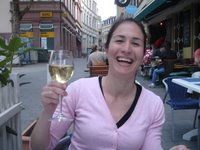
So what about the chocolate? Well, just to prove the point, Wiesbaden, the other side of the river from Mainz and always the land of aristocracy and wealth, got the opposite attention. Because Wiesbaden had no strategic importance to the war effort – and mostly just to show the locals in Mainz that the bombing WAS in fact personal – Hershey bars were dropped here.
Later, in 1947, Wiesbaden became the site of Air Force Headquarters in Europe. One of the Air Force’s first big missions was the Berlin Air lift, which famously provided around-the-clock flights to Berlin, dropping food and provisions to the West Berliners and famously saving them from oppression under a communist rule. This effort all happened from Wiesbaden.
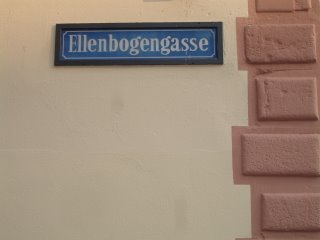
TODAY
Today, it’s a pretty, upscale, cobblestoney town with lots of old folks and fountains that spew forth VERY hot liquid. The fountains spew hot liquid, that is...not the old fogeys. It doesn’t get much tourism, other than those brave old souls who bare it all at the “textile-free” thermal baths. It has a lot of ice cream shops, shoe stores, and is perfect for walking. Think downtown Annapolis, but bigger. And instead of Annapolis’s harbor, sprinkle some hot-water fountains around.

Oh, and to complete the Forrest Gump analogy, in 2009, the U.S. Army Forces in Europe is going to move its headquarters here, making it the focal point of all Army actions in 91 countries on three continents.
REGION
Wiesbaden is in the Rhein valley, known for its white wine and topless blondes who perch themselves atop large rocks and lure sailors to their watery death through their siren songs.
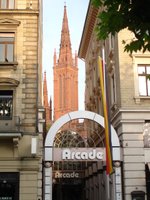
Its valley location makes summers warm and winters mild. Overall, I’d compare the weather here to that of Vancouver, Canada – it rains enough that moss grows on trees and grass is always green, but there are tons of sunny days, so Pecos can enjoy his walks without cowering under my umbrella. This summer has apparently been a “hot” one, with the last couple weeks having consistent highs in the 80s. Hot, but not Texas. The winters see snow, but not too much and at infrequent intervals. Usually an inch here, an inch there and it’ll always melt (or get rained on) in a week.
Nightfall doesn’t come until 10:30 in the middle of the summer – and the sun will rise at about 5:30. But, as with nature, the opposite is true in the winter, with daylight lasting from 8:30 – 4.
It’s about a 20-minute drive to the Frankfurt airport (the biggest in Germany) and a six-hour drive to Berlin. We’re about 1.5 hours from France, three from the Netherlands, and four from Switzerland. Within a six-hour drive are the following: Amsterdam, Berlin, Prague, Salzburg, the Alps, Paris, and the best cheese in the world.
WHAT’S SIMILAR
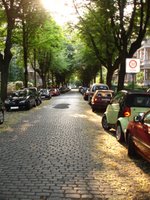
Other than Jolly Old England, Germany is probably the country most similar to the U.S. The radio and MTV sound American, the TV shows are mostly the same (but dubbed), the variety of food options is similar, and there are no big differences in customs (not like in Bulgaria where nodding means no or like in Greece when you are spit on for good luck). The language is not too distant from English, the gum tastes the same, and things generally work like they should.
 WHAT’S DIFFERENT
WHAT’S DIFFERENTGermany is the best country for dogs, as they’re allowed everywhere except for grocery stores (for obvious MUST—BITE—WURST--AND--POOP--IN--DECORATED--FRUIT--BASKET reasons). Smiling at strangers is apparently verboten here, but the dour nature eases once you get to know someone. On the deficiency list, Germans are known for being nosey, passive-aggressive worriers who give unwanted, unsolicited advice and have a VERY different idea of customer service. On the plus side, they’re typically environmentally friendly, law-abiding citizens who value quiet hours and Sunday strolls.
Also, A/C is rare, public transport is EXPENSIVE, and the idea of “health” food is a veggie burger suffocated with hollandaise and a side of fries.
OK, that's all. Pictures and a blog of Prague coming soon.
5 comments:
Wow.. That history was amazing! I guess it was a darn good thing to be on *that* side of the river... hershey is better than death!
I wonder what Mainz is like now- what the economic impact of the bombings on that side was..
I want weather like that here. Maybe I will end up in Germany- if just for weather and food! (and that wine that made you look so happy!)
swolfy
Great posting Justin. I very much enjoyed the history and it seems the "save one for Mainz" is familiar to me, possibly from some reading.
But that, still light at 10:30, or not dark until 10:30, I would be eating dinner at midnight. Ask Kate about dinner time at home in the summer.
DC MOM
Great marketing piece, Justin.
....ok - we'll be right over!
Read the blog to your Oma... skipped the "poop" parts and the negative German comments...so she just loved it!
..now understand your weird and sudden urge for Hershey's chocolate.
As an airline pilot I stay in Mainz several times a month. It is a wonderful little city, and the locals are extremely friendly, especially to Americans. Great shopping in the old part of town, and the Cathedral is jaw dropping beautiful.
As to the "Save one for Mainz" Campaign, as a WWII buff, this has been dis-proven. Mainz was devastated during the war, but American and British Bombers were too concerned with living through the mission, to take a side tour, and drop one on Mainz. From speaking to many crews that flew those missions, "Save one for Mainz" was more of a battle cry, than it was a realistic "off mission" drop. It just did not happen. Thank God they saved the Cathedral, it is awe inspiring!
Great piece! I lived in Wiesbaden, and worked in Mainz, from 2001-2004. They were both beautiful cities then and I enjoyed my time there.
Post a Comment